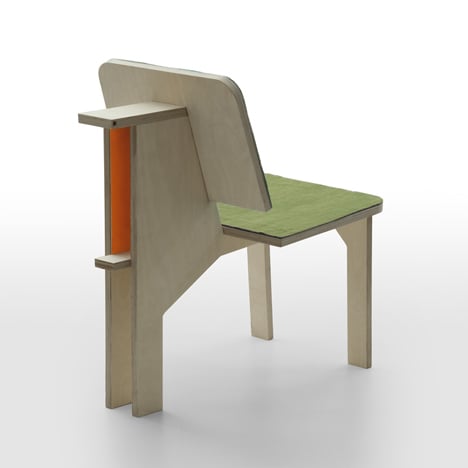Milan 2011: French designer Matali Crasset will present this chair with a fold-out table for Italian brand Danese in Milan next month.
Called Double Side, the seat is designed so the backrest slides up and flips 90 degrees to become a table surface for writing, using a laptop or eating.
See all our stories about Milan »
More about Matali Crasset on Dezeen »
More about Danese on Dezeen »
The information that follows is from Matali Crasset:
Double side, Matali Crasset 2011
Seat: birch multilayer laminate
Colors: natural wood, orange laminate, beige, blue, orange or green felt
“An object isn’t generous enough if it has just a single function” (M.C)
Double side is a versatile seat which can be transformed with a tiny intuitive gesture, into a work tool, the back flips and becomes a small plane on which you can write, use your computer, eat or play.
It’s a new typology of products which breaks the codes of traditional living based on the idea of life borrowed from the bourgeois model which by now is outdated and does not adapt itself to everyday life but continues despite this to influence the space with rigid models and preconceptions, filling it with elements which represents a status more than a real need.
Matali Crasset therefore design this seat not as fixed element, dedicated only for resting but as a tool which allows passing between active and passive situations, which keeps up with life and lets itself be interpreted. The project isn’t a sign, a formal result, but a reflection on a scenario of life in transformation, the product is a physical transposition that derives from it.
“At home today the structures are fixed, like a paused video with a paused picture, life is changing and it’s in movement and it reactivates the video so to speak.
My projects work in the interstices of the activities, in passages between one paused picture to another in order to reattach them to one another and to renew the movement and the action in between the spaces.” (M.C.)
Double Side invites an action, and forwards potential opportunities which are revealed during its use.
In this, objects like Double Side can have a role in influencing life styles, succeed in creating stimulus, in transmitting not only a sense of protection and the comfort of resting but also the pleasure of creativity in modelling personally spaces in according with new visions , with a change in mentality and in behavior ( the non stopping one). Double Side doesn’t stop at the archetype of the seat but updates it always watching the real needs of “seating” and therefore it unifies within itself more traditional elements reevaluated according to contemporary needs: it’s a traditional and comfortable chair in the essentially, but positive, warm and familiar thanks to the use of natural materials like wood and felt, and to the color.
it’s a support plane, of reduced dimensions but sufficient to assure the functionality of such an alternative and informal chair.
It’s a small space which represents the affective heart, a sort of “memory” of the object in which one can put some books, the computer, and safekeeping personal objects. It maintains familiar elements like the materials and recalls familiar gestures like the one of the bolts for fixing together the 2 positions, in order to recreate a connection, a closeness to the person. It’s a tool for managing the annulment of limits between work and private life, for welcoming new technological tools which come with both. It guaranties action but in a less formal and more provisional way, like balancing life and work and manage at the same time 2 distinct situations.
In the spaces shared, the change in front of the use of Double Side can become an indication of the change in predispositions to the reality: from an invite to the search of privacy. Ds actually represents a more rich and open solution, ideal for public spaces as well, in which overlap more activities and behaviors places such as waiting rooms, relaxations centers or informal meeting places at the interior of offices and halls.
See also:
.
| Smith Pro by Jonathan Olivares for Danese |
Xarxa Sofa by Martí Guixé for Danese |
Cau Sospensione by Martí Guixé for Danese |

